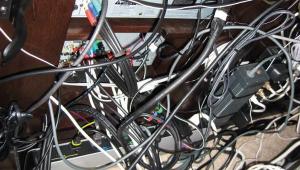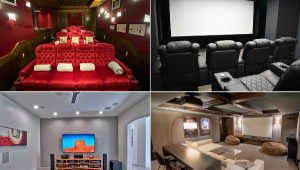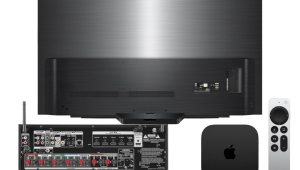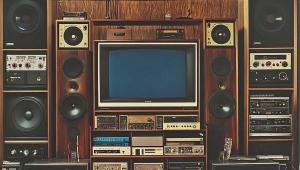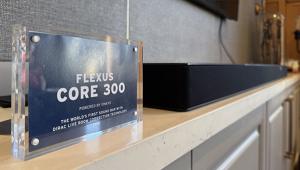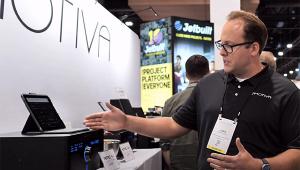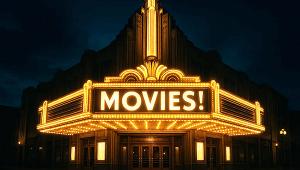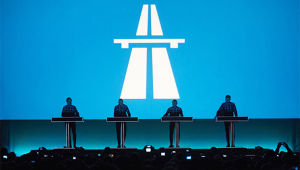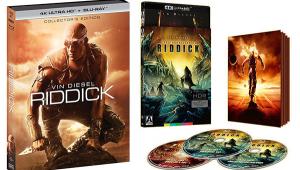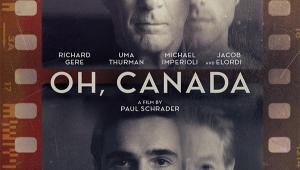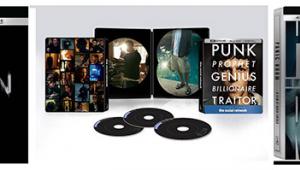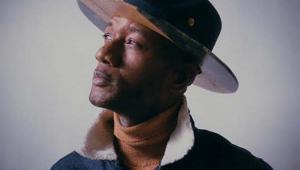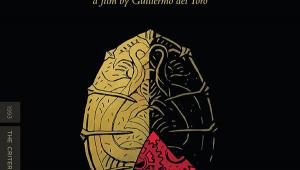Thank you very much Al for your advice, as a matter of fact I purchased the Mini with the 2.6 GHz processor and connected the HDMI output directly to the television for picture and have been shopping around for a DAC either the Emotiva XDA-2 or the Cambridge Audio Azur DacMagic D/A converter as reviewed by sister publication Stereophile.com. I just couldn't find an integrated amp with the inputs required or a HT receiver that sounded as good as my current 2-channel setup at the price range considered. The best part is that I get to continue to incorporate my old gear and under budget, thanks again AL G.
Can I Use a Mac Mini as a Music Server?
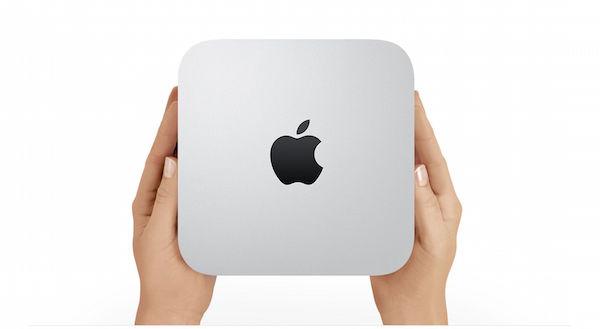
Q I’ve been bouncing around the idea of upgrading my current gear and going digital because my wife and I want the convenience of being able to cue up any piece of music using our iPhones.
My current music system consists of a Bryston 4B amp and Adcom GFP-555 preamp—old school analog stuff, but sounds great when I play CDs. My plan is to purchase a new receiver with HDMI inputs and attach a Mac Mini computer to use as a music server. It’s my thought that I can get a Mac Mini and new HDMI-equipped receiver for under $2,000 and the sound will be comparable to dedicated media servers priced at $2,000 or higher. Am I on the right track? —James Seeds
A I do think you’re on the right track in buying a Mac Mini computer ($499 and up) to use as a dedicated iTunes music server. But I don’t think you need to spend money on a new receiver, which works out anyway since you like the sound of your old gear. Let me explain.
While the Mac Mini has an HDMI output that you can use to send audio to an HDMI-equipped receiver, you’ll be better off using a USB DAC for music listening. A USB DAC is a standalone device that connects to one of the Mac Mini’s USB outputs, converts the digital audio signal to analog, and then routes it to a preamp or receiver via an analog stereo output. What makes USB a superior option to HDMI in this case is that many USB DACs provide an Asynchronous transfer mode that’s effective in reducing digital jitter. (Check out this feature for more info.)
Good USB DACs that you can hook up to your Mac Mini sell for as low as $150. The combined price, then, for your new music server setup would be in the $650 range—well below what you had originally budgeted for a Mac Mini plus a new HDMI-equipped receiver. Setting up the system shouldn’t be difficult, but there are some audiophile best practices you should pay attention to, especially if you want to play high-res audio. Check out this excellent article written by Paul McGowan of PS Audio for detailed instructions on configuring a Mac Mini as a music server.
- Log in or register to post comments


You're right - retail media servers are way overpriced. However, are you looking to stand up a true media server that can distribute media files to various devices on your network, or just have a box with media files directly connected to your HiFi equipment?
I’ll start with the former…
If you don't want to limit yourself to Apple-only devices and their proprietary "ecosystem", you can build your own inexpensive, open-sourced solution with way more features and connectivity. (This was a very rewarding DIY project that has my circle of friends green with envy! ESPECIALLY the Apple fanboys!)
1. Buy yourself an inexpensive system. You can save yourself even more money if you purchase what's known as a "bare bones" system - these usually do not come with a pre-installed operating systems, hence no additional license fee built-in to the cost. There are numerous online retailers that offer models with a quad-core processor for much less than the low-end, dual-core Mini. (If you do plan on upgrading your HiFi equipment some time later, ensure the system has HDMI-out.)
2. Depending on what kind of system you purchased, install the necessary software.
Option A: If an operating system is pre-installed and configured, all you need to do is install media server software. Check out this list of media servers: https://en.wikipedia.org/wiki/Comparison_of_UPnP_AV_media_servers
(FWIW, I've tried several of them but have found myself been using Universal Media Server for the last 3 years. 100% free.)
Option B: If no OS is pre-installed, first install one, then choose the appropriate media server software from the link above. "Vortexbox" and "Audiophile Linux" are especially easy since the respective downloadable images are operating systems that have been pre-configured for listening pleasure.
3. In the absence of an HDMI-port, connect your system to a DAC, then to your HiFi. You can follow Mr. Griffin's suggestion of an external USB model, or you can use an audiophile-quality soundcard like the Xonar Essence STX (or higher).
If you just want to have a box with media files directly connected to your HiFi equipment, Kodi is an EXCELLENT media center that also has free remote apps for Android and iOS.

Option B: If no OS is pre-installed, first install one, then choose the appropriate media server software from the link above.
There are many Linux OS options, but would probably go with Ubuntu. However, projects such as "Vortexbox" and "Audiophile Linux" are especially easy since the respective downloadable images are operating systems that have been specially pre-configured for listening pleasure.

I agree with mtymous1 that you don't need to limit yourself to a Mac and the whole Apple ecosystem. I recently purchased a HP Stream Mini PC for less than 200$. It comes with Windows 8 and HDMI out. I am sure you can connect a USB DAC as well. The HP Stream Mini only has a 32 GB hard drive, so you will need an external hard drive or use a NAS, but even with that, you will easily come in under the price of a Mac Mini.

This all seems too complicated for an arguable sound quality difference. What's wrong with using a $99 Apple TV to stream your digital music from iTunes running on a networked PC? Apple TV has both HDMI and Toslink/optical outputs, so you can choose whatever connection you think works best with your system (I use both...HDMI for my main zone and optical for zones 2/3 since my pre-pro can't pass HDMI to secondary zones). Does Toslink/optical suffer from such terrible jitter that this isn't a viable solution for a $99 device? I have all of my CD's ripped into Apple Lossless and I leave a several-year-old PC on all the time to feed my music from. You get an elegant user interface to choose your music, whether on your TV or from your smartphone (via the Remote app). The only real (and still arguable) drawback here is that Apple TV won't output hi-res (beyond 48kHz/16-bit I think) music files, even though iTunes supports them, nor does it support surround music tracks such as ripped DVD-Audio files that are in WAV format. But if you're really talking about sharing a massive CD-quality library I don't think you can go wrong with Apple TV for $99.
Let me know if I am missing the point.

Like you said, AppleTV won't output beyond 48kHz/16-bit. (Additionally, the highest-res any Mac can deliver natively is 96/24.)
So if Mr. Seeds only purchases lossy content from iTunes or rips CD's at a lossless 44.1/16, it wouldn't matter. (But good luck if you ever want to listen to a lossless 192/24 FLAC file with an AppleTV!)
Mr. Seeds' desire is the convenience of digital, and Apple does a decent job delivering that convenience within their proprietary ecosystem. My intent was to welcome him as new digital adopter by informing that there are less expensive options that deliver a much higher SQ, without being limited to just Apple. That's all.
Happy listening!

Been there, tried that with the AppleTV. No matter what I did with the network it dropped out all the time. Very annoying. I then switched to a Mac Mini for a music server and couldn't be happier.

I have a habit of taking things literally so I conclude from the original question that the desire is to play music from iPhones. Here's how I did that, using my existing stereo system. Its easy to connect, easy to use and sounds as good as your existing system:
http://audioengineusa.com/Store/Wireless/B1-Bluetooth-Music-Receiver
Scott

I use an ipod touch put the analog output into an older DBX expander then to the audio input on my receiver and it works great....and much less expensive than using a mac mini.


Here's a revised response of "Apple wouldn't be my preference."
To the main question of "Can I Use a Mac Mini as a Music Server?" my response is:
Yes, you can use a Mac Mini as a Music Server, but it sounds like you just want a box that delivers media on-demand, directly to your analog, HiFi equipment. Let me know if I’m mistaken. (BTW, does the media reside on the phones? Will it reside on the new Mini? Both? Something else?)
To the statement of "I’ve been bouncing around the idea of upgrading my current gear and going digital because my wife and I want the convenience of being able to cue up any piece of music using our iPhones." my response is:
If convenience is more important than sound quality, then stick with Apple's proprietary ecosystem - it's designed to work easily with other Apple-branded devices.
Existing iPhones + New Mini + iTunes + AirPlay = Convenience.
HOWEVER…
While I completely understand that the overarching intent is to be able to simply access a digital media library from your phone, my argument against the Mac Mini is that for the same cost (or less) of any model, you can achieve a higher SQ throughput, plus more features than the Mini. (I haven’t even touched the subject of video content!) I consider the vast number of how-to testimonials found online, my own DIY-trials, and an existing build performance to be substantial empirical evidence. Furthermore, you can also revert to the proffer in my original post as an example of a DIY alternative: Bare Bones System --> Software --> Internal / External DAC.
(NOTE: Keep in mind that Apple is first and foremost, a HARDWARE manufacturer. One of the key differences in my proposal is the utilization of open source SOFTWARE at the system and application level.)
That said, I personally could not justify spending money on a Mac Mini, since it would easily parlay itself in to the Apple delivery stream of sonic content which is limited by:
- lossy iTunes files (which is an assumption about the bulk of your library),
- the Mini’s 96/24-at-best soundcard hardware,
- the overhead of OSX.
I am fully aware that something like external USB DAC would indeed bypass the hardware limitations of the delivery stream, but what about the software challenges in that stream? Should you really be subjected to lossy compression codecs that are pushed as defaults in iTunes? When you’re trying to enjoy the best possible sound reproduction, does OSX really need to have a myriad of tasks like printing services subtracting from CPU and RAM capacity?
Also, let’s not forget Apple’s business model that employs planned hardware obsolescence -- I GUARANTEE that the Bryston and Adcom gear will still get use, long after your next three iPhones and that Mini. (Remember: Apple is a HARDWARE-first company. Some large percentage of their bottom line depends on how much of their hardware you keep purchasing!)
I’m not suggesting that the Mini won’t work – clearly, it will. Just want to share some of my personal experience that has yielded better SQ and more features outside of Apple’s proprietary ecosystem, and for considerably lower cost -- all without sacrificing the convenience of being able to access my library from a mobile device.
FWIW, I’m an audiophile hobbyist that has adopted the digital era, and maintains that the digitization of sound should be optimized by the engineer at the performance (or from the master recordings). There shouldn’t be a need for much more consumer post-processing to get the purest sound reproduction in digital format.
P.S. For the now-fuming Jobs and Cook disciples, it’s okay to disagree - disagreements also foster learning experiences. So am hoping SOMEONE can propose tips and tweaks that can make readers’ already awesome configurations, that much better!
Thanks.

mtymous1, I bounced around the thought of purchasing one of the barebones boxes and building my own system with a speedy flash drive, Intel processor, dedicated sound and video cards that most likely handles higher resolution formats but for now were content with the nearly 1000 CD's ripped to the AIFF format. Although I started assembling my audio system in the early 90's I'm very happy with the sound and find it difficult to retire the components for a receiver. I even considered an 11 year old Apple G5 tower with optical out that I have kicking around and with the addition of a DAC but the G5 is too big and noisy the Mini is less intrusive, the wife thinks it's cute, easy to use and allows us to create our individual play lists. I get it, start with quality gear with a direct path that doesn't affect the sound quality or add to it, that was me 25 years ago now it's just about enjoying the music whenever we can. Thanks for everybody's input, I plan to incorporate some of the suggestions mentioned and post back how it turns out, J


Since I think we can assume that the music the original poster wants to enjoy is located on two iPhones, how would you propose he upgrade that content beyond "lossy" iTunes quality? In my experience, the only way to do that is to replace it with higher rez files. So, while I totally get (and agree) with your assertions regarding the Mac Mini vs. a homegrown hardware/software solution, in the end, he will still end up with lossy quality. It will just sound a lot better on his home system. So why not take the easiest approach to get there? (see my solution above)...

The original Q says he wants "...to cue up any piece of music using our iPhones...", so I wouldn't assume his content solely resides on the phones. That's why I asked if the media resided on the phones, the new Mini, both, or something else. So if his stuff is in places other than the phones, a Bluetooth receiver (like the http://audioengineusa.com/Store/Wireless/B1-Bluetooth-Music-Receiver) might not be the best solution. (Side comment: That’s a LOT of money for a Bluetooth receiver! I got one from Monoprice for around $50 that I keep in our home gym.)
But if all of his content is lossy and on the phones, then yes, a Bluetooth receiver could work. Just wouldn’t have the benefit of a DAC.

Even after all these keystrokes, I can't believe I forgot to offer a quick-n-dirty solution! I would suggest looking in to a Sony BluRay Player that has DLNA support. I got one for my wife so she could watch Amazon Prime content on the last "dumb" TV we have in the house. It has a TON of apps, network connectivity, and other features, but for the use case of "... cue up any piece of music using our iPhones..." utilizing its DLNA features is also a solution. Since it’s a BluRay player, it has RCA output to directly connect to the original poster’s current analog equipment, and of course HDMI and/or optical (or coax) if there’s ever a desire to purchase a digital receiver.
Unlike the Mac Mini, this little unit can play SACDs, BluRay audio, and FLAC files up to 192/24. (I think it was around $70 at Costco around Christmas.)

iPhones don't natively support DLNA since Apple opines that DLNA competes against AirPlay, but there are several iOS apps out there that support it. media:connect comes to mind.
(Skifta used to be a FANTASTIC app for media shifting/throwing via DLNA, but alas R.I.P. Skifta.)
If you're willing to liberate your iPhone, you should definitely look in to Kodi.
(You should also look in to Kodi as a comprehensive media center solution that works on various platforms.)

It's been over 2 months now and feel it's time for an update.
I picked up a pristine Azur DAC online and connected my HK FL8550 CD Changer it has a Coax output, lined up 20 of my favourite CD's and spent the next 6 hours on Saturday just listening and came to a conclusion fairly quickly, what took me so long?
The sound was very engaging, drew me in to a large soundstage, the detail in the instruments kept my attention and of course the 4B's bass was tight and punchy like I remembered it to be. I'm very happy with the outcome.
I didn't expect too much from our AppleTV (iTunes) using the optical connection to the DAC and the Bluetooth from my iphone, 320 kps MP3's sounded predictable and flat, not very engaging I'd leave this more for background music rather than critical listening. I also played around with the Mac Mini's connections. Preferred using the livelier sound of the USB over the subdued Optical. I played AIFF files using the VLC player instead of the iTunes, sound was much fatter in the bass and had brighter highs than the MP3/iTunes combination I attribute that to the higher bit rate, although somewhat fatiguing after an hours worth of listening. Switched over to the Roxio player for some FLAC files, the sound improved slightly in the midrange and can easily see myself utilizing this format more often.
I wasn't expecting my old HK CD player to sound as well as it did took me by surprise and has got me thinking now what if:
What if I upgrade the DAC, perhaps to a Mytek will the sound improve even more?
I upgrade to a new Pre/Pro Amp with HDMI/USB/Coax/Optical & HiRez capabilities, will the sound be as good without a DAC?
I've decided to attend the TAVES show in Toronto for some equipment auditions next month to help me sort out the combinations.

I was tired of having my 3 and 5 year olds scratching some of Cd's and DVD 's by using them as rolling wheels and frisbees, too early to unbox the vinyl. All this talk of computer sound files got me motivated to drag out an old Dell quad core 2.8 Vostro 230 with maxed out RAM at 3 GB, 240 GB flash drive and a 3 TB 7200 rpm SATA drive as a back up. I purchased a Asus Sound card with both RCA and optical out , downloaded the drivers for Windows 7, decided to connect it to my Acurus Act 3 Pre-amp and I'm off to the races, there's extra slots for a video card or cable. Spent less than two hundred bucks, will look into JRiver or some of the free players for FLAC files
I'm currently loading music files as I type, learned something new from something old
Paul Erickson

Paul,
The specs on that Vostro are more than enough to get some kicka$$ digital sound! Especially with the sound card upgrade...
Am curious about your tinkering... Which Asus sound card did you purchase? In your setup, which output sounded better: RCA or digital?
As an alternative to JRiver, Kodi plays (and rips) FLAC very nicely and has an excellent ten-foot UI. (It does a whole heckuvalot more than play FLAC. LOTS of free content available through Kodi, too.)
For no-frills applications, there's Foobar 2000 and of course VLC which plays practically anything you throw at it.
If you ever get in to DSD hi-rez files, Foobar2000 can play them, and there’s also one from Sony (http://esupport.sony.com/swu/8810). It’s minimalistic, but works very well -- even does DSD at 5.6 MHz.

Every time somebody mentions Mighty Mouse I almost expect Andy Kaufman to jump out of a bush and sing "here I come to save the day".
As for which sound card I utilized; I considered Creative Labs Sound Blaster ZXR and the ASUS Essence STX2, having zero knowledge of the 2 cards I asked for advice from the salesperson, he recommended the cheaper in price Creative Labs because it had more features and bang for the buck, the drawback was it occupied two slots and CL in my experience has irritating driver updates and chose the pricier STX2 which works well.
I tried digital output first, and maybe it's my Acurus Act 3 the sound was bright for my tastes, too edgy kind of like the first time I heard a CD so I settled on RCA as it was softer. I might even by-pass the PreAmp altogether and go direct, that should be interesting.

For grins, I ended up getting a little Intel NUC (http://www.intel.com/content/www/us/en/nuc/nuc-kit-nuc5cpyh.html) for the living room.
I dropped in an SSD and RAM in to the NUC, and then installed Windows 8 and it works flawlessly. (Before you come at me with pitchforks, clubs, and torches for selecting Win8, I did it because I needed Windows Media Center AND compatibility with Intel's free remote keyboard / mouse app.)
We can now do the following in the living room:
- Stream from the media library
- Enjoy up to 192 kHz / 24-bit audio over HDMI without the use of an external DAC. (Recall that Apple sound cards only go up to 96 kHz / 24-bit.)
- Watch webcam streams (basically, DIY home security)
- Watch and record live TV via Windows Media Center (and with the assistance of HDHomeRun Prime)
And since there's that free whyOS remote keyboard/mouse app, wife is loving that she can use her whyDevices instead of (another) remote. This is also one of several methods that harks back to the original intent of "...wanting the convenience of being able to cue up any piece of music using our iPhones."
Even though we’re only using it as a high-resolution media streamer and set top box for now, it can do a whole lot more since it’s a legit, dual-core computer.
When I tally the costs of the NUC, SSD, and RAM, it was less than half the price of the cheapest, dual-core mac mini. (Add $100 for Windows 7/8. Nothing for Linux -- that's right, it’s compatible with Linux.)
P.S. It even supports 4K TV, so whenever I jump on that, it’ll be ready.

...is also available, and it comes with optical out:
http://www.intel.com/content/www/us/en/nuc/nuc-kit-nuc5pgyh.html
...all for less than half of the low-end Mac mini.

Thanks for taking the time to discuss this topic. yes, We can Use a Mac Mini as a Music Server. Recently I bought Mac mini for music purpose and I tried to use Mac mini as a Music server then I was facing a lot of issues then took assistance from Apple id support number through visit: https://www.appletechnicalsupportnumbers.com/apple-id-support/ and they assist me very nicely in a short period of time.

